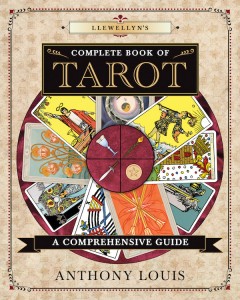The Cards as Living Entities
In just a few months (August, to be precise), Llewellyn’s Complete Book of Tarot by the knowledgeable experienced, and delightful writer Anthony Louis will be available.
He covers the subject of tarot as completely as a concise overview allows and does so objectively, presenting background on the history of tarot as well as the various traditions. Throughout the book, he highlights some important gems from some of tarot’s most influential practitioners.
In this excerpt, he shares an important observation by Aleister Crowley. Many people may miss Crowley’s wisdom because of his reputation. That is too bad because this is important stuff. Too many people think that by reading enough books or downloading enough lessons, they will absorb what they need to become great readers. But there is so much more to reading the cards than just their interpretations. The cards interact with each other in a spread and with us in our daily lives, if we only pay attention.
From the forthcoming Llewellyn’s Complete Book of Tarot (learn more or pre-order HERE):
The Cards as Living Entities
The notorious occultist Aleister Crowley has compared learning the tarot to making a new set of friends. Viewing the cards as living individuals, Crowley suggests methods that enable students to form personal relationships with the entities of the tarot. The view of the individual cards as living beings may seem a bit far-fetched, but it is not so different from the Jungian view that the tarot signifies universal archetypes of the collective unconscious.
Crowley believed that newcomers to the tarot can truly appreciate the cards only if they observe closely how the tarot behaves over a substantial period of time. In other words, an understanding of the tarot comes only through extensive experience with the cards, treating them as if they were sentient beings. How do you get to Carnegie Hall? Practice, practice, practice!
Crowley cautions that merely intensifying one’s study of the cards as “objective things” rather than as “living individuals” is not sufficient. The student must live with the cards, and the cards in turn must live with the student. The tarot novice and the living cards must take the time to get to know one another. How else can a relationship form and grow?
To quote Crowley verbatim: “A card is not isolated from its fellows. The reactions of the cards, their interplay with each other, must be built into the very life of the student. … How is he to blend their life with his? The ideal way is that of contemplation. … The practical every-day commonplace way is divination.”[1]
Occultist Dion Fortune carried Crowley’s “cards-as-living-entities” metaphor even further, suggesting that students sleep with their cards, much like young lovers who spend nights together exploring every nook and cranny of each other’s bodies.
[1] Aleister Crowley, The Book of Thoth, Appendix A, (San Francisco, CA:Weiser, 1969), p.249.










I just finished reading a galley of this I received via NetGalley, and I have to say it is a great resource. I say that both as a Tarot learner and as librarian. I will be posting a review of it to my blog soon to share with my readers. An excellent book. Best, and keep on blogging.